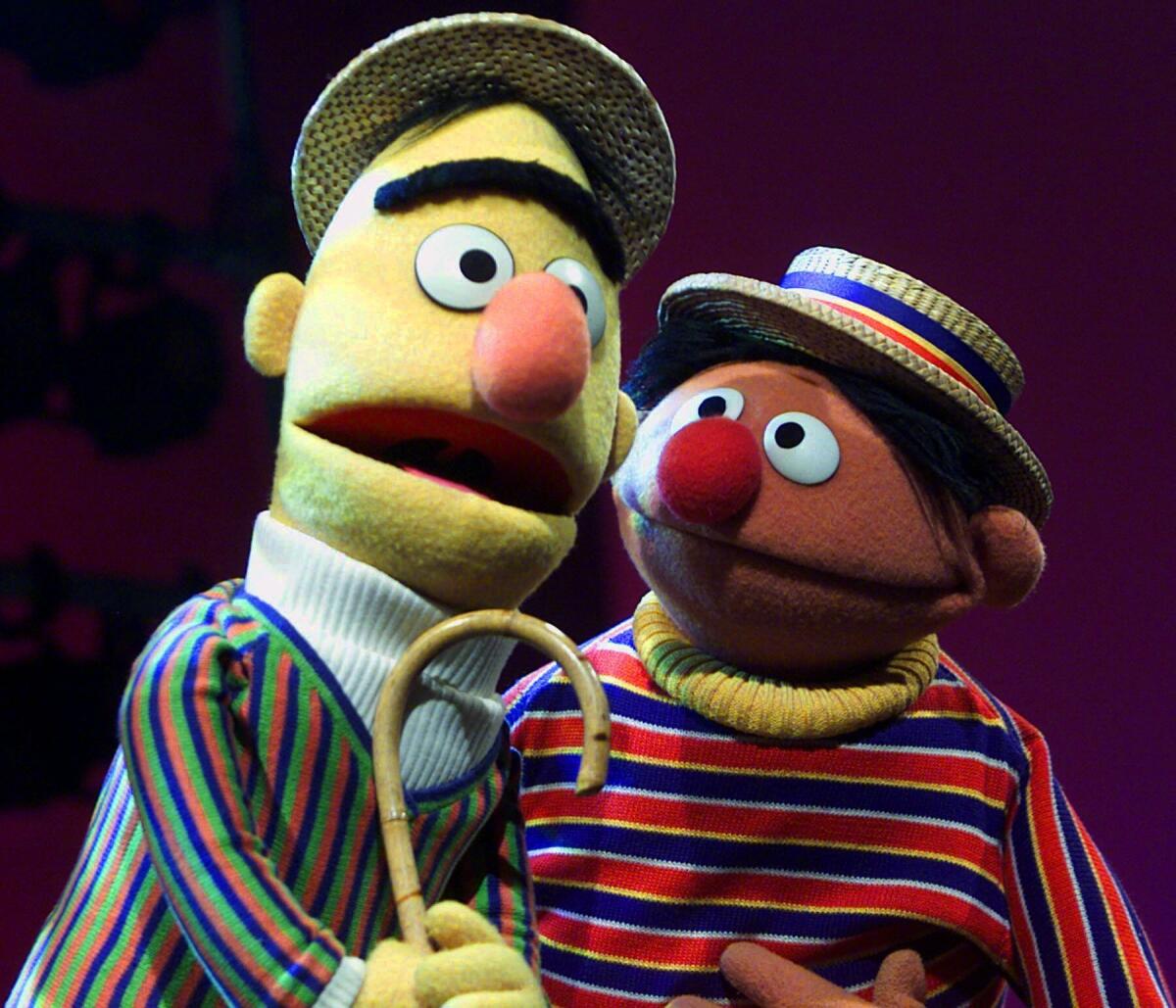As decision day arrives, San Bernardino’s KVCR says it will enter FCC’s spectrum auction

Muppets Bert, left, and Ernie of the children’s program “Sesame Street.”
- Share via
In an era when some people believe there is too much TV, Americans who depend on free, over-the-air broadcasting are facing a future in which they will have less to watch.
Dozens of stations could leave the air in a few years as a result of the federal government’s auction of TV transmission frequencies, known as the broadcast spectrum. The government is planning to pay stations for their spectrum so that it can be sold to wireless carriers or other technology companies such as Google that want it to meet the growing demand for mobile data.
Station owners must inform the FCC today of their interest in selling back their spectrum in the March 29 auction. The stations to be auctioned won’t be revealed until that time, but the San Bernardino Community College District, home of the PBS member outlet KVCR, told The Times that it would be filing an application to participate.
According to the FCC’s website, the sale of the spectrum will “benefit consumers by easing congestion on wireless networks, laying the groundwork for ‘fifth generation’ (5G) wireless services and applications, and spurring job creation and economic growth.”
But in the process, viewers who watch free, over-the-air TV because they decline or can’t afford to subscribe to cable or a satellite video provider will end up with fewer channel choices.
Estimates on how many viewers depend solely on over-the-air TV vary. Nielsen says it’s 11% of all U.S. TV households, which comes to 12.3 million homes. Market research company GfK’s Home Technology Monitor puts the figure at nearly 15%, or 17.6 million homes.
Join the conversation on Facebook >>
GfK says a growing portion of these homes -- 5.4 million -- are cable cord-cutters who watch video online. There are apparently enough of them out there for Cablevision to offer its customers a broadband Internet package that includes a TV antenna.
Speculators have been buying up small, low-revenue stations around the country in recent years in anticipation of the auction. Many of the stations likely to participate are foreign-language programmers, religious broadcasters, affiliates of nostalgia TV networks, and Public Broadcasting Service members operated by nonprofit organizations or schools.
Major media companies, including CBS and Comcast’s NBCUniversal, have indicated that they will sell back some spectrum in some markets where they own more than one TV station.
“The potential for disruption and inconvenience to the viewer is enormous,” said Dennis Wharton, executive vice president for the National Assn. of Broadcasters, a trade organization that represents the interests of TV stations. “The loss of diversity could be fairly significant.”
NEWSLETTER: Get the day’s top headlines from Times Editor Davan Maharaj >>
The money that can be realized in the process explains why station owners are taking a hard look at giving up their broadcast properties. In the opening-bid prices put out by the FCC in October, KVCR was valued at $628.6 million, the highest of any station in the Los Angeles market.
Bid prices are expected to go down considerably if a large number of stations decide to put their spectrum up for auction. But even at half that opening amount, the potential windfall is tantalizing for the owner of KVCR.
“If you’re owned by a community college or a school district, those are huge numbers you can’t pass up,” said an investment banker who has advised station owners on how to navigate the auction.
Other educational institutions around the country, including Howard University in Washington, D.C., which owns WHUT, have said they intend to participate in the auction.
If KVCR disappears from the airwaves, over-the-air viewers in the San Bernardino area should be able to see PBS shows on Los Angeles public stations KOCE and KLCS, depending on how the post-auction transition shakes out.
SIGN UP for the free Essential Arts & Culture newsletter >>
A representative for KOCE, which had its signal valued at $581 million, declined to comment on its auction plans. The Los Angeles Unified School District, which owns KLCS, has previously announced that it will give up part of its spectrum and share a channel with KCET, a Los Angeles public station that is not a PBS member. (Stations that give up their signals can stay on the air by negotiating to share channel space with another outlet).
The San Bernardino Community College District’s decision to enter the auction raises questions about the future of its Native American programming service FNX, which supplies programming to PBS stations and broadcasts on KVCR’s digital sub-channel 24.2. KVCR’s 17 hours of local programming serving the Inland Empire would also have to move to other stations or stream online if the station goes away.
A representative for the college did not comment on KVCR’s plans beyond confirming that it would participate in the auction.
PBS officials are concerned that patches of areas across the country will not be within reach of broadcast signals carrying the service once the auction process is complete and stations are moved off the air or onto other channels. According to GfK, 19% of viewers who watch public TV at least once a week are in broadcast-only homes.
“When the auction results are announced, PBS and other national public media organizations like the Corporation for Public Broadcasting and Association for Public Television Stations are planning to work together with local and national partners to address any unserved areas that might be created by the auction,” said PBS spokeswoman Jan McNamara.
ALSO
Spotify hit with second songwriter lawsuit in two weeks
Time Warner extends Chairman and CEO Jeff Bewkes’ contract through 2020
Kevin Spacey and his production partner join Ryan Kavanaugh’s Relativity Media
More to Read
From the Oscars to the Emmys.
Get the Envelope newsletter for exclusive awards season coverage, behind-the-scenes stories from the Envelope podcast and columnist Glenn Whipp’s must-read analysis.
You may occasionally receive promotional content from the Los Angeles Times.









